Introduction
Das sichverständlichmachen ist Selbstmord der Philosophie.
To make oneself understood is suicide for philosophy.
—Martin Heidegger (1989, § 259, p. 435; quoted in Philipse, 1998, p. 291)
Heidegger, says philosopher Richard Rorty, was a resentful, ungenerous, disloyal, and deceitful man (May 3, 1998). He was also a member of the Nazi party from 1933 until it was disbanded by the Allies in 1945 (Leaman, 1996, p. 66). Yet he managed to write what is probably the single most influential philosophical text of the twentieth century. In particular, Heidegger’s thoughts on death and authenticity have profoundly affected the thinking and practice of existential psychotherapy.
Particularly since the publication in English of the works of Farías (1989) and Ott (1993), there has been furious debate about the nature and extent of Heidegger’s Nazism (e.g., Neske & Kettering, 1990; Wolin, 1991; Rockmore & Margolis, 1992; Rockmore, 1992; Philipse, 1998, pp. 246-276; Polt, 1999, pp. 152-164; Collins, 2000). But there can be little doubt that his participation in the Nazi regime, and his subsequent silence and evasions — even to the attempted revision, without notice, of his Holocaust-period writings (Philipse, 1998, pp. 250-251) — have called into question not only his own personal authenticity but also the validity of his thought.
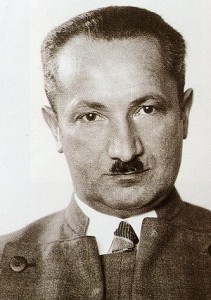 |
| The young Heidegger |
Indeed, it may be his silence, for the thirty-one years that he lived and wrote after the destruction of the Nazi state, that has damaged Heidegger the most. As Emmanuel Levinas, at one time one of Heidegger’s most important students, has put it, “But doesn’t this silence, in time of peace, on the gas chambers and death camps lie beyond the realm of feeble excuses and reveal a soul completely cut off from any sensitivity, in which can be perceived a kind of consent to the horror?” (Levinas, Winter 1989, quoted in Milchman & Rosenberg, 1996b, p. ix).
What is remarkable is this. Discussion of Heidegger’s participation in the National Socialist party has come, according to philosopher Herman Philipse, in three waves (1998, p. xiii). First, immediately after the war, on January 19, 1946, Heidegger was stripped of his professorial rights because of his involvement with the Nazis. Second, on July 25, 1953, Jürgen Habermas, writing in the Frankfurter Allgemeine Zeitung, raised the question of whether Heidegger’s recently published Einführung in die Metaphysik was in fact an apology for National Socialism. Third, in 1983 — ironically, the fiftieth anniversary of Hitler’s rise to power — Heidegger’s 1933 pro-Hitler rectoral address at Freiburg University was republished by Heidegger’s son, motivating the publication, in 1987, of Victor Farías’s and, in 1988, Hugo Ott’s historical investigations into Heidegger’s life (Farías, 1987, in French; Ott, 1988, in German). And, in case all this might be considered simply European esoterica, on June 16, 1988, Thomas Sheehan published, in The New York Review of Books, a review of Farías (1987) entitled “Heidegger and the Nazis” (June 16, 1988).
In light of all this, one might expect that a recent standard text on existential psychotherapy, such as Schneider & May (1995), which refers to Heidegger seven times, including a laudatory exposition, would mention the question of Heidegger’s Nazism and its effect on his philosophy. One would be disappointed.
There is no question that existential psychotherapy has relied heavily on Heidegger’s thinking on death and authenticity (e.g., Yalom, 1980, pp. 30-33; May, 1983, pp. 105-108; Frankl, 1988). The question then becomes whether — and to what extent — the enterprise is tainted by Heidegger’s Nazism, and by its own silence on the issue.
Death and them
The primary source for Heidegger’s views on death is §§ 46-53 of Being and Time (1927/1962, pp. 279-311). This section has been discussed numerous times (e.g., Edwards, 1979; Gelven, 1989, pp. 136-155; Mulhall, 1996, pp. 114-120; Young, 1998; Philipse, 1998, pp. 352-374; Polt, 2000, pp. 85-88). Here is the general account.
Inauthenticity
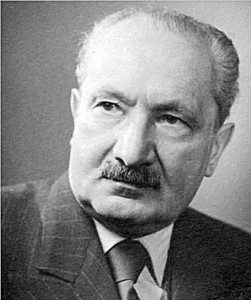 |
| Heidegger in 1955 |
Dasein — the human being, the person, the individual, me — is, ordinarily, inauthentic. It is governed not by autonomous choice but rather by them — by public opinion, popular judgment, received wisdom. When one is inauthentic, they become the self. In thought, feeling, desire, judgment, and action, the I-self is dissolved away, leaving the they-self; one becomes a mere function of them. We take pleasure and enjoy ourselves as they do; we read, see, and judge about literature as they do; we find shocking what they find shocking (Heidegger, 1927/1962, § 27, p. 164).
Why do we do this? From public pressure, certainly; they always seek to impose a kind of dictatorship or subjection (Botmässigkeit) upon us (§ 27, p. 164). But we do it also from our own motives, our own desire to limit our distance (Abständigkeit) from them (§ 27, p. 164). But then why would we wish to do that? Not because we are inherently social beings; not because we are moved by the face or the sufferings of the other; not because we are seized by the other or responsible for the other; but rather because by becoming a function of them, by being “tranquilized” (beruhigend) (§ 38, p. 222), we are “disburdened” (entlasten) (§ 27, p. 165) of the disturbing weight which an authentic I-self must bear — our own inexorable mortality. Inauthentic life, says Heidegger, is a flight from death. They regulate the way one is supposed to behave towards death; tranquilization keeps Dasein from thinking about its death (§. 51 p. 298). And, since death is Dasein’s ownmost (eigenste) possibility, we become authentic (eigentlich) only by relating properly to our own death.
The nature of death
This leads to Heidegger’s discussion of death. Death, says Heidegger, reveals itself as that possibility “which is one’s ownmost (eigenste), which is nonrelational (unbezügliche), and which is not to be outstripped (unüberholbare)” (§ 50, p. 294). Heidegger does not give a systematic exposition of these three key terms, which are repeated together throughout the text. It is clear, however, that the terms are interconnected parts of a single solipsistic thought. Because death is my ownmost possibility, I cannot outrun it; because death is my ownmost possibility, my death has no relation to any other; because my death is nonrelational, it belongs to me alone. Thus Dasein can only die for itself. “No one can take on oneself the dying of another,” says Heidegger. “Each Dasein must take on itself its own dying” (Keiner kann dem anderen sein Sterben abnehmen.… Das Sterben muß jedes Dasein jeweilig selbst auf sich nehmen) (§ 47, p. 284).
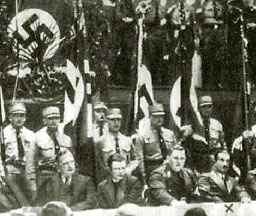 |
| Heidegger, seated far right, at a Nazi rally |
For the same reason, Dasein dies alone. “The nonrelational character of death… isolates Dasein down to itself” (Die… Unbezüglichkeit des Todes vereinzelt das Dasein auf es selbst) (§ 53, p. 308) “Death is just one’s own” (Tod ist je nur eigener) (§ 53, p. 309; emphasis in original). And — most important — when Dasein stands face to face with the possibility of death, “all its relations to any other Dasein are cut off” (So sich bevorstehend sind in ihm alle Bezüge zu anderem Dasein gelöst) (§ 50, p. 294). Finally, since death is my ownmost possibility, I cannot outstrip death, since beyond death there is no more Dasein. “Death is a possibility of being which Dasein always has to take upon itself,” says Heidegger. “With death, Dasein itself stands before its ownmost capacity for being” (Der Tod ist eine Seinsmöglichkeit, die je das Dasein selbst zu übernehmen hat. Mit dem Tod steht sich das Dasein selbst in seinen eigensten Seinkönnen bevor) (§ 50, p. 294).
The call to authenticity
Death is Dasein’s potential negation of itself; death “is the possibility of the absolute impossibility of Dasein” (§ 50, p. 294). The nonbeing of its own finitude gives rise to Dasein’s anxiety before the “possible impossibility of its existence” (§ 53, p. 310). But even in its tranquilized inauthenticity, Dasein hears the voice of the I-self, the call of conscience (§ 57, pp. 321-322) to accept its mortality and individuality.
Dasein can choose to reject this call and remain inauthentic. Or Dasein can choose to listen, plunge into anxiety and solipsism (§ 40, p. 233), and accept alienation from them. When the issue is death, “all being-with-others will fail us” (§ 53, p. 308); authentic Dasein is “wrenched away from them” and isolated down to itself (§ 53, p. 307). One then sees that death is not a future event, but a sign of the nullity of any being one might have beyond simply being-in-the-world: “When Dasein is resolute, it takes over authentically in its existence the fact that it is the null basis of its own nullity.… The nullity by which Dasein’s Being is dominated primordially through and through, is revealed to Dasein itself in authentic Being-towards-death” (§ 61, p. 354). One then “takes over” one’s “thrownness” (§ 74, p. 434). By being-toward-death, Dasein becomes fully autonomous, authentic — as Heidegger puts it, resolute.
When we admit that our death is “possible at any moment” (daß er jeden Augenblick möglich ist) (§ 52, p. 302), then “the possibility will have to be understood unweakened as a possibility, cultivated as a possibility, and endured as a possibility in our conduct” (muß die Möglichkeit ungeschwächt als Möglichkeit verstanden, als Möglichkeit ausgebild und im Verhalten zu ihr als Möglichkeit ausgehalten werden) (§ 53, p. 306). Heidegger calls authentic understanding of death as my ownmost possibility “running on ahead toward the possibility” (Vorlaufen in die Möglichkeit).
Running ahead toward death
If we run ahead toward our own death, we are able to be ourselves as a whole, because in anticipating death we also anticipate all possibilities of existing that will precede it; “one is liberated in such a way that for the first time one can authentically understand and choose among the factical possibilities lying ahead of that possibility which is not to be outstripped” (§ 53, p. 308). Because death is essentially individual, anxiety enables me to be myself and frees me from the bonds of them, so that being-free-for-death is the same thing as being free to become myself (§ 53, p. 308). “Becoming free beforehand for one’s own death frees one from one’s lostness” (Das vorlaufende Freiwerden für den eigenen Tod befreit von der Verlorenheit) (§ 53, p. 309).
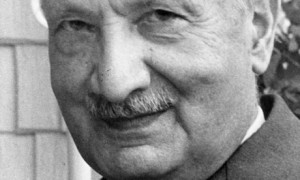 |
| Heidegger smiles |
This Vorlaufe or running ahead reveals to Dasein that it is lost in the they-self, and brings it face-to-face with the possibility of being itself in an impassioned freedom toward death — a freedom which has been released from their illusions (§ 53, p. 311). When the call of conscience is understood, Heidegger says, one realizes that one is lost in them. Resoluteness brings Dasein back to its ownmost potentiality-for-being itself. This freedom is a lonely thing to bear. “Death, understood in authentic anticipation, isolates Dasein in itself” (Die im Vorlaufen verstandene Unbezüglichkeit des Todes vereinzelt das Dasein auf es selbst) (§ 53, p. 308). But when one has an understanding of being towards death — towards death as one’s ownmost possibility — one’s potentiality for being becomes authentic and wholly transparent (§ 62, p. 354).
The problem of the Holocaust
There is much that is attractive about this analysis. In many ways it all fits neatly into our culturally received nineteenth-century ideals of death, autonomy, vision, fortitude, salvation. Heidegger hardly earns our wrath by attacking bourgeois conformity, cowardice, and bad taste. It particularly resonates, for us, with a specifically American icon — the lone outsider, dependent on no one, living by his own moral code — although it most likely derives from the martial virtues as set forth, for example, by Ernst Jünger. And there is nothing wrong with such ontological virtues as freedom, resoluteness, authenticity, self-possession.
But here we are brought up short by exactly that which Heidegger — silent and unrepentant — refused, throughout his life, to discuss. In a world of cattle cars and concentration camps, systematic exterminations, what Heidegger called der Fabrikation von Leichen, the manufacture of corpses, the sobbing of the victims, the graves in the air — in such a world, are such solipsistic virtues adequate? Or do we need, as Levinas says, “a breach made by humanness in the barbarism of being” (Levinas, 1986, p. 187)?
Graves in the air
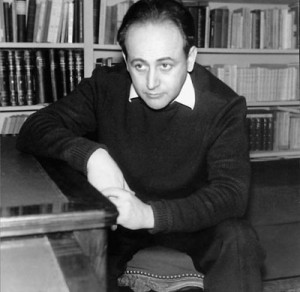 |
| Paul Celan |
What Heidegger’s thinking about death must confront is the smoke hanging over the ovens of Auschwitz. It is striking that even Rüdiger Safranski’s emotionally detached and noncommittal biography of Heidegger (1998) — Richard Rorty calls it “evenhanded” (May 3, 1998) — was originally entitled Ein Meister auf Deutschland. As Rorty points out, the title inevitably alludes to the chilling poem Death Fugue (Todesfugue) written in 1945 by Paul Celan (collected and translated in Celan, 2001, pp. 30-33) — a concentration-camp survivor born Pesakh Antschel in Bukovina — which has the refrain, “Death is a master from Germany” (der Tod ist ein Meister aus Deutschland), and which refers to the pall of smoke over the crematoria in the death camps as “a grave in the air” (ein Grab in der Luft).
Heidegger just twice mentions these camps, on a single day, December 1, 1949, in statements, never published, during the course of two lectures before a select audience in Bremen. In the first lecture, lamenting the mechanization of agriculture, Heidegger said:
Agriculture is now a mechanized food industry. As for its essence, it is the same thing as the manufacture of corpses in the gas chambers and the death camps, the same thing as the blockades and reduction of countries to famine, the same thing as the manufacture of hydrogen bombs (Neske & Kettering, 1990, p. xxx; Sheehan, June 16, 1988, pp. 41-42; Leaman, 1996, p. 59; Manning, 1996, p. 20; Milchman & Rosenberg, 1996a, p. 217).
There are two things immediately striking about this passage — first, the equation of mechanized agriculture and the systematic extermination of the Jews; and, second, the implication that, whatever the Germans did, the Allies and the Communists did much the same. The remark stunned Levinas into silence. “This stylistic turn of phrase,” he wrote, “this analogy, this progression, are beyond commentary” (Winter 1989, p. 487, quoted in Manning, 1996, p. 20).
The second mention of the graves in the air came later on the same day, in a second lecture, which directly implicates our concern for a philosophy of death. Heidegger said:
Hundreds of thousands die en masse. Do they die? They perish. They become items of the standing reserve for the manufacture of corpses. Do they die? Hardly noticed they are liquidated in extermination camps.… Dying, however, means bearing death in its essence. To be capable of dying means to be capable of bearing this death. But we are able to do so only when the essence of death has an affinity to our essence (Neske & Kettering, 1990, p. xxix; Leaman, 1996, p. 60; Milchman & Rosenberg, 1996a, p. 218).
There are several ways to read this passage. Auschwitz survivor Primo Levi speaks of camp inmates “too empty really to suffer. One hesitates to call them living; one hesitates to call their death death” (Levi, 1959, p. 82). Is Heidegger conceding, as Milchman & Rosenberg propose (1996a, p. 219), that the inhumanity of the extermination camps deprived their victims even of their own death? Is this an apology — or even just an acknowledgement?
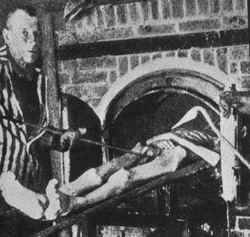 |
| Preparing a grave in the air at Auschwitz |
Context and history suggest otherwise. First, the passage syntactically expresses an almost total abrogation of responsibility. The victims perish. They are liquidated. The passive voice subverts accountability. There is no agent of these deaths; these victims simply — somehow — perish, become dead, turn from inventory into corpses. This is the reading that makes the second passage consistent with the first.
There is an additional consideration in Heidegger’s own writings. The exterminated do not die their deaths, but rather they perish, succumb; even while living they are Bestandes — inventory, holdings, assets, livestock — der Fabrikation von Leichen, for the manufacture of carcasses. The victims did not really die because they could not bear death in its essence. Who are these beings who are without authenticity, without resoluteness, and thus livestock? Who are these beings who do not die but perish like animals, their graves in the air?
In § 74 of Being and Time, Heidegger asks from where authentic Dasein draws its resoluteness, its being-free for death, its ability to die rather than perish. He answers: from having been thrown into a specific inheritance (Erbe). Resoluteness, he says, accesses its own real possibilities of authentic existing from the inheritance into which it is thrown and which it accepts (Die Entshlossenheit… erschließt die jeweiligen faktischen Möglichkeiten eigenlichen Existierens aus dem Erbe, das sie als geworfene übernimmt) (§ 74, p. 435; emphasis in original).
Authentic resoluteness, freedom for death, is a possibility that Dasein has first inherited — and then has chosen. Thus, whether one is capable of bearing this death, whether the essence of death has an affinity to one’s essence, depends on one’s fate and one’s inheritance as prior conditions to one’s choice. “Destiny (Geschick) is not put together out of individual fates (Schiksal).” Where individuals have fates, a people, a community (Volksgemeinschaft) has a destiny. Only in communicating and in battle does the power of this destiny become free (§ 74, p. 436).
 |
| The smokestacks over an Auschwitz crematorium |
And this has an dreadful resonance with Heidegger’s June 30, 1933, rectoral address at Freiburg University. The battle for the university, he says, will be fought out of the strengths of the new Reich that Chancellor Hitler will bring to reality. The battle must be fought by “a hard race with no thought of self, a race that lives from constant testing and that remains committed toward the goal to which it has committed itself” (Wolin, 1991, p.p. 44-45). The outsiders in the camps, who merely perished, whose graves were smoke in the air, never had this potential for authentic existence in the first place.
Yet, despite all this, current thinking about death is suffused with Heidegger’s cold and lonely and ultimately amoral solipsism. Do we have an alternative?
REFERENCES
Celan, P. (2001). Selected poems and prose (Felstiner, J., Trans.). New York, NY: W. W. Norton.
Collins, J. (2000). Heidegger and the Nazis. New York, NY: Totem Books.
Edwards, P. (1979). Heidegger on death: A critical evaluation. Monist Monograph, 1. LaSalle, IL: The Hegeler Institute.
Farías, V. (1987). Heidegger et le nazisme. Lagrasse: Verdier.
Farías, V. (1989). Heidegger and Nazism. Philadelphia, PA: Temple University Press.
Frankl, V. (1988). The will to meaning: Foundations and applications of logotherapy.New York, NY: New American Library. (Original work published 1969).
Gelven, M. (1989). A commentary on Heidegger’s Being and Time (Rev. ed.). DeKalb, IL: Northern Illinois University Press.
Heidegger, M. (1962). Being and Time (Mcquarrie, J., & Robinson, E., Trans.). New York, NY: Harper & Row. (Original work published 1927)
Heidegger, M. (1989). Beiträge zur Philosophie (Vom Ereignis). In Gesamtausgabe. Frankfurt a/M: Klostermann.
Leaman, G. (1996). Strategies of deception: The composition of Heidegger’s silence. In Milchman, A., & Rosenberg, A. (Eds.), Martin Heidegger and the Holocaust (pp. 57-69). Atlantic Highlands, NJ: Humanities Press International.
Levi, P. (1959). Survival in Auschwitz. New York, NY: Orion Press.
Levinas, E. (1986). The philosophical determination of the idea of culture (Smith, M., & Harshav, B., Trans.). In Levinas, E. (Ed.) (1998), Entre nous (pp. 179-187). New York, NY: Columbia University Press.
Levinas, E. (Winter 1989). As if consenting to horror (Wissing, P., Trans.). Critical Inquiry, 15(2), 487. (Original work published 1988)
Manning, R. (1996). The cries of others and Heidegger’s ear: Remarks on the agriculture remark. In Milchman, A., & Rosenberg, A. (Eds.), Martin Heidegger and the Holocaust (pp. 19-38). Atlantic Highlands, NJ: Humanities Press International.
Milchman, A., & Rosenberg, A. (1996a). Heidegger, Planetary Technics, and the Holocaust. In Milchman, A., & Rosenberg, A. (Eds.), Martin Heidegger and the Holocaust (pp. 215-235). Atlantic Highlands, NJ: Humanities Press International.
Milchman, A., & Rosenberg, A. (1996b). Introduction. In Milchman, A., & Rosenberg, A. (Eds.), Martin Heidegger and the Holocaust (pp. ix-xiii). Atlantic Highlands, NJ: Humanities Press International.
Mulhall, S. (1996). Heidegger and Being and Time. London, UK: Routledge.
Neske, G., & Kettering, E. (Eds.). (1990). Martin Heidegger and National Socialism: Questions and answers. New York, NY: Paragon House.
Ott, H. (1988). Martin Heidegger: Unterwegs zu seiner Biographie. Frankfurt a/M: Campus Verlag.
Ott, H. (1993). Martin Heidegger: A political life. New York, NY: Basic Books.
Philipse, H. (1998). Heidegger’s philosophy of being: A critical interpretation. Princeton, NJ: Princeton University Press.
Polt, R. (1999). Heidegger: An introduction. Ithaca, NY: Cornell University Press.
Rockmore, T. (1992). On Heidegger’s Nazism and philosophy. Berkeley, CA: University of California Press.
Rockmore, T., & Margolis, J. (Eds.). (1992). The Heidegger case: On philosophy and politics. Philadelphia, PA: Temple University Press.
Rorty, R. (May 3, 1998). A master from Germany. The New York Times Book Review, section 7, p. 6.
Safranski, R. (1998). Martin Heidegger: Between good and evil (Osers, E., Trans.). Cambridge, MA: Harvard University Press.
Schneider, K., & May, R. (1995). The psychology of existence: An integrative, clinical perspective. New York, NY: McGraw-Hill, Inc.
Sheehan, T. (June 16, 1988). Heidegger and the Nazis. The New York Review of Books, pp. 41-43.
Wolin, R. (Ed.). (1991). The Heidegger Controversy: A critical reader. New York, NY: Columbia University Press.
Yalom, I. (1980). Existential psychotherapy. New York, NY: Basic Books.
Young, J. (1998). Death and authenticity. In Malpas, J., & Solomon, R. (Eds.), Death and philosophy (pp. 112-119). London, UK: Routledge.

- Previous Post: Ayahuasca and the Grotesque Body
- Next Post: Thinking About Death II: Levinas
- More Articles Related to: Books and Art



Ernest Becker’s Denial of Death, an exploration of the key insights of psychoanalysis and existential thought, is one of the most powerful books I have ever read. He describes the death/annihilation terror as the prime repression, and argues that people’s attempts to avoid these feelings lead to much violence and harm toward others.